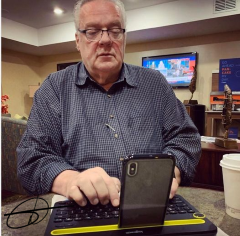You’ll never know how predictable you are until someone acknowledges how often they’ve heard you say or do something. Predictable. Same Reaction.
In the case of standing up to something necessary, then that’s a good broken record stance. But if you say the same thing to the same kind of input, the record may need to be changed.
There was a time when record players played what we commonly call “vinyl.” Long-play recordings that spun on a tabletop or portable machine at 33 1/3 revolutions per minute. Hence, 33 1/3, 78, and 45s are common. 45s were often one song on each side and smaller sized. 78s was the older style album. 33 1/3 were the Long Plays.
In an IT class I taught decades ago, we would talk about the difference between a record and a diskette/hard drive/CD/DVD as a recording device. A record needle, placed anywhere you wanted, followed the groove from start to finish. There was only one groove. Computer storage can write and read files from anywhere on the surface, depending on the controls and limitations of said device.
It could be you have a bad needle, and it can be replaced, sometimes expensively. Other times, the record is the problem. Repaired or replaced, it too can be an expensive process.
On either side, a scratch or something marred the surface, and the record would keep playing the same loop of noise repeatedly. Bump the device, which hopefully skips over the aberration and picks up after the defect.
This is why we kept our records in the cardboard and paper sleeves it was shipped with. Protect the surface! Get it? Good.
I’m sure there are other ways of looking at these historical records, but this is as I remember them early this morning.
Key thought. The surface is marred. The needle needs help to get out of the broken rut. The sounds you hear are mere repetitions of the recording as the needle tries to do its job. The defect prevents it from playing for the remainder of the recording. That repetitive sound will never change until something happens to help the needle skip something that it cannot repair.
Key thought. We all have defects and respond the same way over and over. Enough so that it’s predictable. Good? Bad? Depends on you, the situation, and the responder. Feast or famine, nothing changes until something changes.
Key thought. Most defects can not be repaired to a “new” condition. For the life of the record, these defects remain. They may wear down over time, but they will always be there.
This morning, I’m thinking about something I have no time to deal with. Maybe this week? Perhaps. The key is that a broken record will always repeat what the marred groove dictates without an opportunity to improve the process of moving on down the groove.

Thank you for reading.
Please share with others.
It helps me get my book written!

